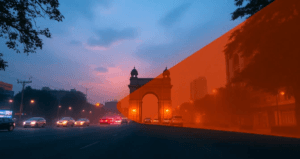13°C Temperature Difference in Mumbai: Alarming Growth of Microclimate Zones and Urban Heat Island Effect
A recent study has revealed concerning microclimate zones forming in Mumbai, with temperature differences of up to 13°C across the city. The research by Respirer Living Sciences highlights the intensifying Urban Heat Island (UHI) effect, where densely built areas experience significantly higher temperatures compared to greener, less developed zones. Between March 1 and March 22, areas like Vasai West and Ghatkopar recorded high temperatures of 33.5°C and 33.3°C, while Powai, known for its greenery, was cooler at 20.4°C. This stark difference underscores the growing impact of urbanization on the city’s climate. The UHI effect is driven by heat-retaining infrastructure like concrete buildings and limited vegetation. The study also covers the wider Mumbai Metropolitan Region, including parts of neighboring districts.

13°C Temperature Difference in Mumbai: Alarming Growth of Microclimate Zones and Urban Heat Island Effect
A recent study has uncovered a striking climate divide within Mumbai, where temperature differences as high as 13°C are now being recorded between the city’s most developed areas and its greener pockets. This alarming gap, highlighted in a report by climate-tech startup Respirer Living Sciences, underscores how rapid urbanization is worsening Mumbai’s “urban heat island” (UHI) effect—a phenomenon where concrete-heavy zones trap heat, making them far hotter than surrounding regions.
The Heat Hotspots
Between March 1 and March 22, 2024, certain parts of Mumbai endured intense heat, with Vasai West and Ghatkopar emerging as two of the hottest neighborhoods. Vasai West recorded an average temperature of 33.5°C, while Ghatkopar followed closely at 33.3°C. These areas, characterized by dense construction, limited green cover, and sprawling infrastructure, absorbed and retained heat more aggressively. In stark contrast, Powai—a suburb dotted with lakes, parks, and tree-lined streets—registered a significantly cooler average of 20.4°C during the same period. This 13.1°C temperature gap within a single city highlights how urban planning choices directly impact local climates.
What’s Driving the Urban Heat Island Effect?
The UHI effect occurs when natural landscapes are replaced with heat-absorbing materials like concrete, asphalt, and glass. Buildings, roads, and industrial zones act like sponges, soaking up sunlight during the day and slowly releasing it at night. This cycle prevents the city from cooling down, creating a “heat trap.” Meanwhile, areas with ample greenery, water bodies, or open spaces stay cooler because plants release moisture (a process called transpiration) and provide shade, while water bodies absorb and dissipate heat.
Mumbai’s rapid urbanization has intensified this divide. Over the past few decades, the city has prioritized high-rises, highways, and commercial hubs, often at the expense of green spaces. For instance, neighborhoods like Ghatkopar and Vasai West have seen massive infrastructure projects, including metro lines and housing complexes, which contribute to heat retention. In contrast, Powai’s lakes and protected green zones act as natural coolants, shielding it from extreme temperatures.
Why This Matters
Extreme heat isn’t just uncomfortable—it’s a public health risk. Prolonged exposure to high temperatures can lead to heat exhaustion, dehydration, and worsened air quality. Vulnerable groups, such as the elderly, children, and outdoor workers, face heightened risks. Additionally, the UHI effect strains energy resources as residents rely more on air conditioning, leading to higher electricity demands and increased greenhouse gas emissions.
The study also reveals that the UHI effect isn’t limited to Mumbai’s city limits. It spans the entire Mumbai Metropolitan Region (MMR), which includes parts of Palghar, Thane, and Raigad districts. This means suburban and semi-rural areas on the city’s outskirts are also experiencing temperature spikes as development expands. For example, newly developed zones in Thane or Navi Mumbai, with their growing concrete footprint, are likely to mirror the heat patterns seen in Vasai West or Ghatkopar in the coming years.
The Role of Climate Justice
The temperature divide also raises questions about equity. Wealthier neighborhoods, like Powai or South Mumbai’s upscale colonies, often have better access to green spaces and water bodies, while densely populated, lower-income areas in central or northern Mumbai lack such amenities. This disparity means marginalized communities bear the brunt of extreme heat, with fewer resources to cope.
Solutions on the Horizon
Addressing the UHI effect requires reimagining urban design. Experts suggest:
- Expanding Green Infrastructure: Planting trees, creating urban forests, and developing parks can cool neighborhoods. Mumbai’s mangrove forests, for instance, act as natural air conditioners.
- Rethinking Construction: Using reflective materials for roofs and roads, designing buildings with ventilation, and incorporating green walls or rooftop gardens can reduce heat absorption.
- Protecting Water Bodies: Lakes, ponds, and wetlands must be preserved to maintain their cooling effects. Powai Lake, for example, plays a key role in moderating local temperatures.
A Call for Action
The Respirer Living Sciences report serves as a wake-up call for policymakers, urban planners, and citizens. While Mumbai’s development is inevitable, balancing growth with sustainability is critical. Simple steps—like prioritizing green zones in new projects or retrofitting old buildings with eco-friendly materials—could mitigate the UHI effect.
As climate change intensifies, cities like Mumbai must adapt. The 13°C temperature gap isn’t just a statistic—it’s a warning. Without intervention, the city’s heat islands could become uninhabitable during peak summers, threatening public health, ecosystems, and economic stability. The time to act is now, before the divide grows hotter.
You must be logged in to post a comment.